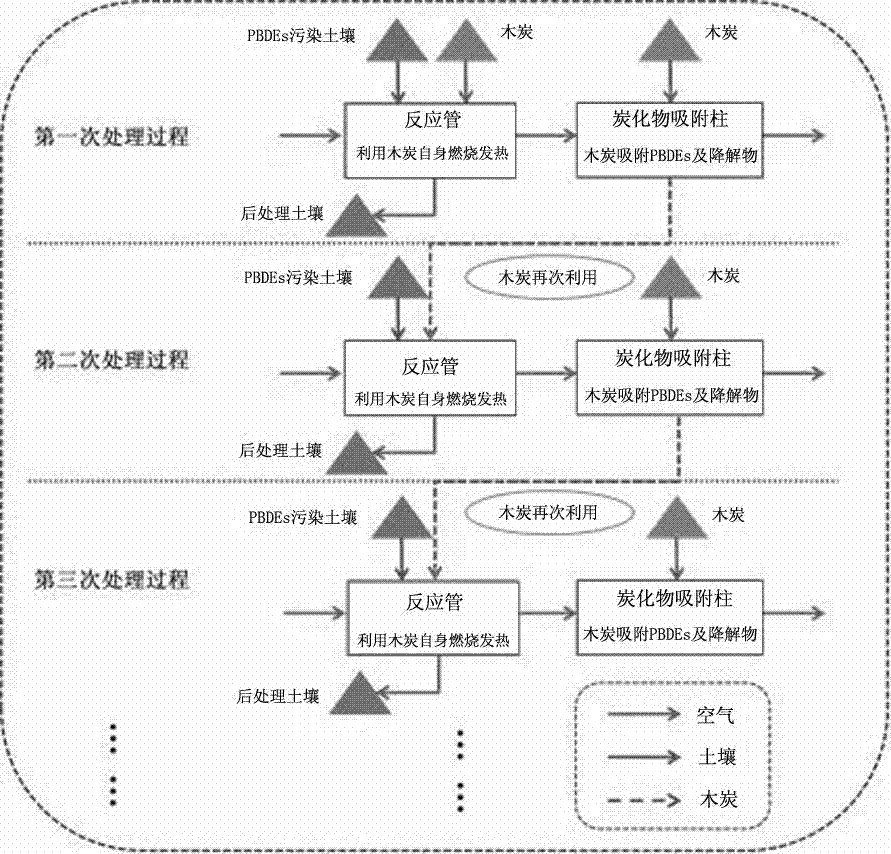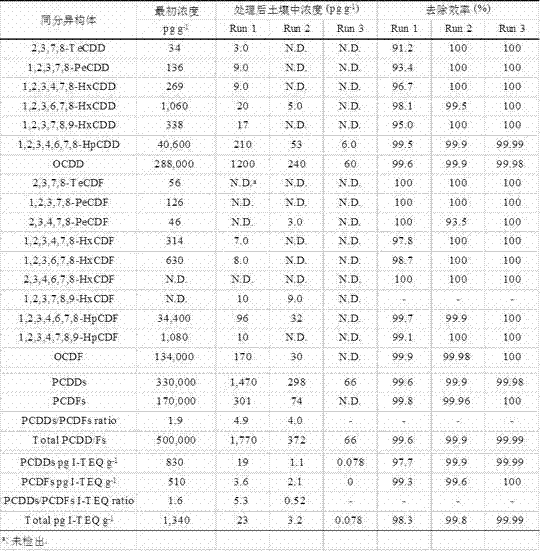Novel thermal desorption restoring system and novel thermal desorption restoring method for treating POPs (persistent organic pollutants) polluted soil
A technology for contaminated soil and remediation systems, applied in the field of new thermal desorption remediation systems, can solve the problems of few and few application technologies, and achieve the effects of saving energy, high economic benefits, and simplifying the remediation process.
- Summary
- Abstract
- Description
- Claims
- Application Information
AI Technical Summary
Problems solved by technology
Method used
Image
Examples
Embodiment 1
[0034] A novel thermal desorption repair system for treating POPs polluted soil, the novel thermal desorption repair system includes a thermal desorption treatment system and a tail gas treatment system; the thermal desorption treatment system includes a constant temperature device and a reaction device, the reaction The device is placed in a constant temperature device; the tail gas treatment system includes a soil adsorption column, a water collection part, a cooling part, a charcoal adsorption column and XAD resin, and the devices in the above tail gas treatment system are connected through communication parts; the thermal desorption The treatment system and the tail gas treatment system are connected through communication components. Further, the connecting part is a polytetrafluoroethylene hose or a glass tube.
[0035] XAD resin is an aromatic hydrocarbon polymer (also known as: macroporous adsorption resin or fully porous resin), widely used in hydrophobic compounds; se...
Embodiment 2
[0051] This embodiment is a preferred scheme based on Example 1, and the novel thermal desorption restoration for the treatment of POPs-contaminated soil includes the following steps:
[0052] 1. New thermal desorption treatment process
[0053] (1) Weigh 50g of sand, 25g of charcoal and 75g of soil (charcoal accounts for 25%) and mix the charcoal and soil evenly to obtain a soil charcoal mixture;
[0054] (2) Transfer the sand to the reaction tube, spread it flat, and use a ruler to measure the distance from the upper end of the reaction tube to the sand and record it;
[0055] (3) Pour the mixed soil charcoal mixture into the reaction tube, spread it flat, and measure the distance to the upper end, and record;
[0056] (4) After filling the soil charcoal mixture, fix the reaction tube in the incubator, insert the induction tubes of thermocouples at equal intervals according to the height of the sample in the reaction tube, and measure the temperature changes of different sa...
Embodiment 3
[0077] This example is a preferred solution based on Examples 1 and 2. This example is a new type of thermal desorption treatment for organochlorine pesticides (OCPs) polluted soil. Before the treatment, the concentration of organochlorine pesticides (OCPs) polluted soil is : 16 mg kg -1 , the components mainly include: hexachlorobenzene (HCB), DDT (DDT) and hexahexazone (HCHs).
[0078] The thermal desorption repair method refers to Example 2.
[0079] (1) Processing efficiency
[0080] After thermal desorption treatment, the residual amount of OCPs in the soil is only: 0.25-0.46 mg kg -1 , The degradation rate can reach more than 97%.
[0081] (2) Content of pollutants in exhaust gas
[0082] After thermal desorption treatment, the concentration of OCPs in the tail gas is 0.02-0.06 mg Nm -3 Within the range, no more toxic organic pollutants such as dioxin were detected.
PUM
 Login to View More
Login to View More Abstract
Description
Claims
Application Information
 Login to View More
Login to View More - R&D
- Intellectual Property
- Life Sciences
- Materials
- Tech Scout
- Unparalleled Data Quality
- Higher Quality Content
- 60% Fewer Hallucinations
Browse by: Latest US Patents, China's latest patents, Technical Efficacy Thesaurus, Application Domain, Technology Topic, Popular Technical Reports.
© 2025 PatSnap. All rights reserved.Legal|Privacy policy|Modern Slavery Act Transparency Statement|Sitemap|About US| Contact US: help@patsnap.com



